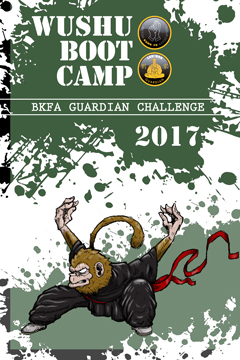WUSHU BOOT CAMP

This Years’ Guardian Challenge, set by Aimee Seymour, is to
complete three rounds of fundamental Wushu drills. This will take an hour to
complete.
Taking part in this challenge will be of great benefit to
your Kung Fu practice, introducing exercises that build overall fitness,
stamina, promote looseness and good posture, improve flexibility utilising
dynamic methods, build jumping power, build core strength and not only focus on
individual stances, but the all-important smooth transition from one stance to
another. Taking part will not only benefit your Kung Fu, you will also be
raising money for the Lau Gar Trust Charity by getting sponsorship. The Charity
works to promote and improve the learning of Lau Gar.
Having spent two weeks training in China during April 2016,
Aimee learnt many basic Wushu exercises, essential to beginners, from Coach Xia
and his Instructors. This Challenge is made up of a selection of these
exercises, and as such, will also be of great benefit to those of you who are
attending this years’ BKFA Summer Course where you will be learning from our
special guest Instructor, Coach Xia.
How to do
the Challenge
- Download the Guardian Challenge structure sheet.
This lists all of the exercises, the order to perform them in and the
quantities or lengths of time appropriate to each exercise.
- Click on the video links to access tutorial videos for each exercise.
- Teach each exercise to your students so they are familiar with these and know how to perform them correctly before taking on the challenge.
- Download the sponsor form and start collecting sponsorship. Participants who collect more than £30 will receive a free Challenge T-shirt or you can purchase one for £15 (please indicate the size required.)
- You will need someone with a stopwatch to keep time for the exercises, or, use a timing device or App that sounds an alert every minute so you know when to move on to the next technique.
- If your club doesn’t have a matted floor, it is advisable to wear trainers or suitable training shoes for this Challenge as it involves a group of jumping exercises.
Challenge
Structure
- The challenge is made up of four sections:
- Warm Up (5 minutes)
- Phase One – Jumps (5 minutes)
- Phase Two – Walks (7 minutes)
- Phase Three – Stances (6 minutes)
The Warm up is to be performed once. Phases One to Three are
to be performed three times.
The Warm up initially involves running and other travelling
exercises so the perimeter of the training space is to be used. The final two
Warm up exercises are static, at this point you can organise your students into
lines to complete these and in readiness for Phase One.
Phase One consists of exercises that are performed on the
spot with no travel, so students are to be organised into lines spaced appropriately
for performing the exercises. The 5 minute time-frame for this phase is
approximate as these exercises have a quantity assigned to them not a time
value. These reps are to be called so that students can keep a steady pace,
complete these at the same time and focus on technique and form. From testing
out the challenge, we have found that it has taken around 5 minutes to complete
this phase.
Phase Two consists of travelling exercises. Students will
perform walking drills. Students are to be organised into rows ensuring
sufficient space between them as some of the exercises require them to swing
their legs out to the front and the sides. The students will travel from one
side of the training space to the other and will then immediately turn around
and continue, back and forward. These exercises are each to be performed for a
minute. Once the minute is up the students continue in the direction they were
travelling and change to the next exercise. It is useful to place a marker at
each end of the training room (eg, a chair/bag/shoe etc) to indicate where the
back row should turn around, this will avoid the possibility of the front row
turning before the rows behind and colliding with them.
Phase Three consists of three exercises to be timed for 2
minutes each. The first is a traveling stance routine led by the left leg. The
second is a stance exercise performed on the spot with no travel. The third is
a repeat of the first traveling stance exercise to be led with the right leg.
All three exercises are to be called at a slow, steady pace so that students
are performing movements at the same time.
Quality over
quantity
The timing and lack of rep calling for the exercises in
phase two will mean that students are free to work to their own speed and
perform as many reps as they can within each minute. It is very important to
emphasize the difference between performing a correct technique quickly and
rushing, the real benefit is in focussing on quality and not quantity. Posture
and correct form are a vital part of these exercises, the tutorial videos focus
on this. With regular practice of these exercises, students will build the
strength that aids these movements and will naturally gain speed and
flexibility without having to force it.
Injuries
If a student has an injury that prevents them from
performing some of the exercises, for example, the jumping exercises, they can
still take part and substitute these for a different exercise – eg, smaller
hops as opposed to jumping as high as possible, or even squats etc.
Downloads:
Click to download Poster
Click to download Challenge Sheet
Click to download Sponsor Form
Videos
Click to View Challenge Videos